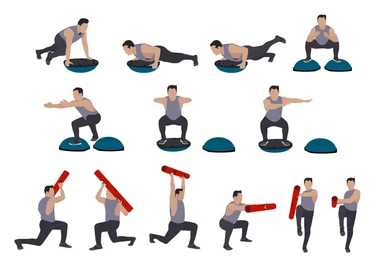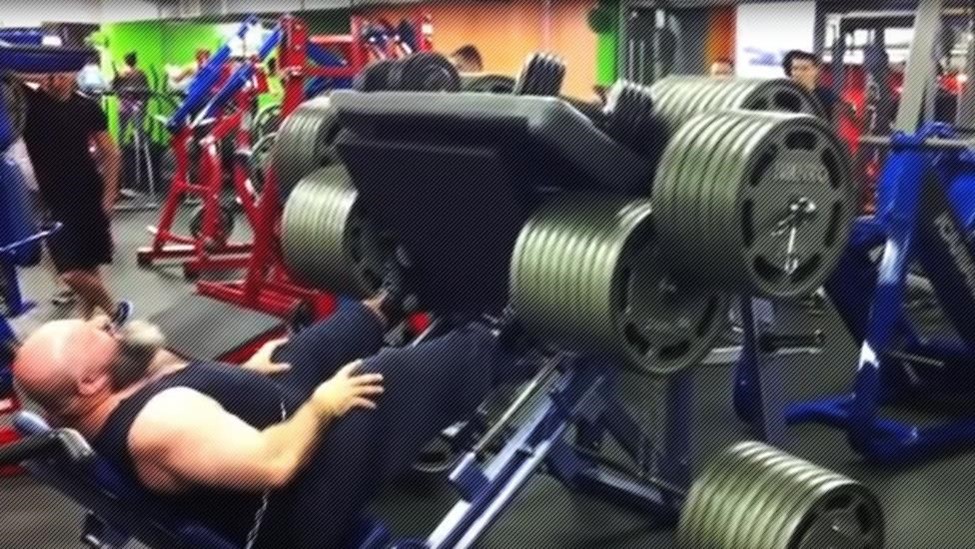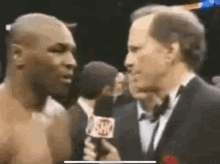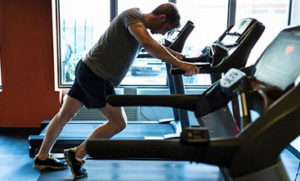15 IDIOTIC MUSCLE BUILDING MISTAKES TO AVOID

Avoid These Muscle Building Mistakes!
So from the title, I know idiotic is a strong word. I just had to get your attention because the information we’ll be discussing is extremely important. The following article covers the 15 muscle building mistakes you should avoid.
There’s a very high chance you’re making at least a handful of these mistakes in your own training.
Honestly, if you read all the way through, take all 15 of these points, and apply them to your program, you’ll be instantly set on the right track. Cleaning up these mistakes could easily make the difference between consistently gaining muscle from week to week, versus spinning your wheels and making little to no progress like so many people do.
So, let’s cut through the B.S. and all the misinformation put out by these fitness influencers and fake natties. I’ll go ahead and outline exactly what you need to do as a legit natural lifter to make real, significant gains over the long term.
Muscle Building Mistake #1:
The first mistake I want to discuss will probably ruffle some feathers right off the bat. I’m sure some people are going to disagree with me here, but the mistake is centering your workouts around getting a pump.
Yes, the pump feels great. It’s motivating, it’s…satisfying (even Arnold would agree).

But, it’s not a significant driver of muscle hypertrophy in and of itself. You can logically reason this out without even needing to look at studies or the precise biology behind it.
If you sat on your couch right now using no resistance whatsoever and just flexed your biceps repeatedly as hard as you could, you could create a huge arm pump off of that alone.
Or better yet, ahead and grab a pair of 3 pound dumbbells and perform thousands of flys until you’re blue in the face. You’ll probably end up with the biggest chest pump of your life.
However, I think we’d all agree that that wouldn’t be the best way to build muscle.
There’s nothing wrong with getting a pump, and if you’re truly training hard, then a pump is a completely normal byproduct of that. You should be experiencing a pump to some degree, and you can somewhat use it as a tool for gauging muscle activation to confirm that you are in fact stimulating the muscle you’re trying to target.
But, that’s primarily what it is. It is more so a side effect of your training. It is not the underlying cause of muscle growth or the thing that you should be mainly focused on.
Muscle Building Mistake #2:
The second mistake falls along the same lines: using “fatigue” as your gauge for success.
Just like the pump, fatigue is also a byproduct of intense exercise. However, it is not a direct stimulator of muscle hypertrophy on its own. Just because you’re tired, sweating, breathing heavily, nauseated, or urinating all over yourself uncontrollably, it doesn’t necessarily mean that any of those things are going to lead to muscle growth.
It’s perfectly possible to perform a completely ineffective workout as far as building muscle is concerned, yet still feel highly fatigued from it.
So, don’t go into the gym with this mindset that your goal is to just aimlessly beat yourself up and “get in a good workout.” If the primary goal of your session is to stimulate hypertrophy, then there are specific parameters that need to be in place for that to happen which we’ll talk about shortly.
(I’ve also talked about this in more detail in my article on the best muscle building workout plan.)
Muscle Building Mistake #3:
Yet another “false gauge” for building muscle is relying on muscle soreness.

Soreness can be a satisfying thing because it’s sort of a reminder of the hard work you put in. It does indicate that some level of damage has been done to the tissue, but just like the pump and fatigue, muscle damage is also not a direct driver of hypertrophy in and of itself.
You could create a ton of muscle damage in your legs by just standing up right now and performing jumping jacks for the next 3 hours straight. You’d be ridiculously sore tomorrow, but that wouldn’t be an effective way to build lower body muscle over the long term. The adaptations you’d get from something like that would be more endurance related.
You’ll also tend to get the most sore when you expose your muscles to a novel stimulus. That applies to beginning lifters in general, experienced lifters coming back from a layoff, or those introducing a new exercise into their program.
You’ll also find that certain muscle groups tend to be more susceptible to soreness than others.
At the end of the day, being sore doesn’t necessarily mean you stimulated hypertrophy, and not being sore doesn’t necessarily mean you didn’t. The one potential use for soreness, just like the pump, is that it can be somewhat used as a gauge for muscle activation.
For example, say you were trying to train your lats. The next day your biceps felt totally massacred, but you don’t feel anything in your lats. That could be an indication that your technique might need adjusting.
Or, if you were trying to train your quads but weren’t not quite sure whether your glutes were doing most of the work, but the next day your quads are very sore, that would help to confirm that you were in fact targeting your quads effectively as far as exercise selection and form go.
So, muscle pump, fatigue, and soreness are not primary drivers of hypertrophy on their own.
Even if they were, then ultra lightweight, high rep, high volume circuit training would be the absolute best way to get jacked. Also, marathon runners would have the most massive tree trunk legs out of anyone.
So what is the primary driver of muscle growth?
The answer is: mechanical tension. It’s applying load to the targeted muscle fibers and training them very close to or all the way to muscular failure. That means, to the point where you can’t do any more reps in proper form despite your best effort.
Muscle Building Mistake #4:
This leads directly to the next mistake. Dead simple, in theory, yet easily the single biggest mistake of all: the number one thing that prevents most people from truly transforming their body in the way they’re after is not training hard enough.
More specifically, the mistake is not going close enough to true muscular failure on your sets.
Muscle growth is an evolutionary survival mechanism to adapt your body to the demands of the environment. If those demands don’t cross a certain threshold, your body won’t have a strong enough incentive to make adaptations.
The stressor needs to be right up close or all the way to the maximum limit that you’re currently capable of if you want to see significant growth. Otherwise the body just says “hey, the current state we’re in is already good enough to deal with this.”

I’m not exaggerating when I say this, but if you’re never making this face on at least some of your sets, if you’re not letting out involuntary grunts or yelps here and there, if you never feel nervous before performing a particularly challenging lift, if you can honestly say that you’ve never straight up soiled yourself in the middle of the gym during a hard leg workout…Okay that’s going too far.
But if those first couple are never happening, then you’re almost certainly not training hard enough for maximum gains.
And when it comes to effort level per set, you really shouldn’t be leaving any more than 3 reps in the tank on most sets as an absolute minimum. 1-2 reps short of failure is probably the optimal zone to base the majority of your sets around. Here and there you can really push the limit with those all out failure sets.
Muscle Building Mistake #5:
The next mistake is something I’ve been talking about like a broken record for the last 15 years. It is: not tracking your workouts.
Tension is the primary stimulus for growth, but in order for the muscle to grow continually bigger over time, that tension needs to consistently increase. AKA, you need to progressively overload.
This is essentially what your entire training program should be centered on.
You need to train close to failure on your sets, and slowly increase the workload over time. If you want to accomplish that in the most efficient way possible, you need to be recording your workouts.
![]()
You can still make progress by improvising as you go. But, it’s not going to be anywhere near as effective as taking a more calculated, structured approach to your training.
Gaining muscle is about very small improvements extrapolated over the long term. There is no better way to track those improvements than by knowing exactly what you did in the previous workout. Then, you can plan what you need to do in the next workout. This is what will help you progress further.
It could be just one extra rep with the same weight. For example, in the next workout you add another rep, then in the following one another rep, then a small 5 pound increase the workout after. Then you use that weight to train for reps again. Rinse and repeat.
And, there are other methods of progressive overload that can be used beyond increasing the weight and reps. For example, you can use slower negatives, rest-pause training, more difficult exercise variations, etc.
All it takes is a few quick seconds to jot this stuff down in a notebook or in your phone after each set. It’s incredibly easy to do, yet can pay dividends over the long term.
Also, tracking your workouts is not just about giving you clear targets to aim for during each workout. It also allows you to see firsthand that your overall program is on the right track.
Physical muscle growth is a very slow process that can’t be accurately assessed in the short term. Yet, strength is something you can clearly measure from week to week. Since size and strength are directly intertwined for the most part, your training logbook is what you use to confirm that you are in fact gaining muscle even if you can’t visually see it yet.
If the numbers in the logbook are consistently going up, then you’ll know that you’re also consistently gaining muscle.
The reason you keep coming back stronger is because the muscle is hypertrophying. Whereas, if the numbers have stagnated, that’s how you know that your muscle gains have also stagnated. At that point, you know that something in your program is off and needs to be corrected.
If you try to rely only on visual changes to determine when your progress has stalled, it could take months before you truly realize it. But with a training logbook, you can identify it very quickly to get yourself back on the right track.
Muscle Building Mistake #6:
Changing your workouts too often is our next mistake.
I know it can be incredibly easy to fall for that shiny object syndrome with all these different training techniques and exercise variations you find online nowadays.
Someone posting a basic flat dumbbell press is nowhere near as sexy and eye catching as a kneeling iso-lateral paused cable fly drop set supersetted with a clapping bosu ball pushup.
However, if you’re always mixing around your training variables in terms of exercise selection, exercise order, volume, rep ranges, rep execution, advanced technique, etc., then it’s going to be extremely difficult to accurately track progressive overload. You don’t have anything concrete to measure each workout against.
Muscle confusion is not a thing.
Your muscles don’t have a miniature brain of their own where they magically decide to stop responding if you perform the same exercise. All they respond to is the degree of mechanical tension they’re being placed under. Period.
It’s actually far more effective for hypertrophy to keep your training variables constant and focus on maximizing your progress within those variables for a consistent cycle of training.
Not only because it allows you to track your progress accurately, but it also maximizes the effectiveness of your workouts. This is because it gives you a chance to refine and master your lifting technique on a given set of movements, rather than just being mediocre at a very long list of different ones.
I believe it was Bruce Lee who said, “I fear not the man who has practiced 10,000 curling variations once; I fear the man who has practiced 1 curling variation 10,000 times.”

Muscle Building Mistake #7:
This mistake might sound a bit obvious, and all the details of this one are beyond the scope of this article. Let’s talk about improper exercise selection.
Now, you don’t need to become some kind of anatomy or bio mechanics Jedi in order to build a solid physique. But if you’re looking to get the best results possible, then you do need to put in the time to gain a reasonable understanding of each major muscle group on the body and what their functions are.
Then, you want to look over your program and make sure you have a proper range of exercises to target those functions. Don’t just blindly pick a bunch of exercises you swiped through online and randomly mash them together.
Like we talked about in a previous point, mechanical tension is the primary driver of hypertrophy.
If you’re not directing that tension toward the specific muscle fibers that you want to grow, that’s quite obviously not going to do you any good.
For example, if you’re trying to target your lats and your main focus is on overhand pull ups or overhand pulldowns, your lats may not even grow optimally. Many people don’t realize that these exercises are actually more upper back than lat focused.
Or, perhaps you’re not aware of basic triceps anatomy. If you’re not including some triceps work with your shoulders in a more flexed position to emphasize the long head–which is the biggest portion of the triceps that’s most likely to be undertrained–you’ll probably be leaving some upper arm gains on the table.
Or maybe you have the common misconception that squats and leg presses are enough to build your hamstrings. In reality, those movements hardly train the hamstrings for hypertrophy at all. In fact, if you’re not incorporating hip extension and knee flexion movements in your program, your hamstrings are going to lag behind.
Muscle Building Mistake #8:
Another mistake when it comes to the topic of exercise selection is over emphasizing certain muscle groups.
More specifically, the mistake lies in doing what a high percentage of lifters do, especially beginners. They get too caught up in training what would be considered the “showy” muscles–usually the chest and biceps.
If you search through YouTube fitness videos, it’s pretty much always chest- and biceps-related content that get the most views. If you take a look around most commercial gyms, presses, flys, and curls are typically the most common exercises you see.
In reality, your biceps are the smallest major muscle group on your entire body and don’t require anything fancy to build effectively. Your pecs also don’t carry nearly as much total mass as you’d think either.
The pecs are roughly equal in volume to the triceps, the lats, and the traps. So, while building a bigger chest and biceps is obviously important for your physique as a whole, there’s no need to treat those areas with such high importance relative to others.
There’s also no need to fall for all the B.S. clickbait content out there that makes you think you need a million different exercise variations to optimize your biceps peak and build the inner-upper 1/18th of your pec fibers.
For the record, your shoulders are actually the single largest upper body muscle group. Well developed delts, paired up with a muscular upper back, will probably do more in terms of making you appear strong and muscular than your chest and biceps will.
Muscle Building Mistake #9:

Related to exercise selection is the mistake of intentionally creating instability during your lifts.
Whether that’s using a swiss ball or a bosu ball, or lifting unorthodox objects like you see in a lot of Instagram and TikTok posts, or certain unilateral exercises that force you to keep the weights balanced during the set… It never ends.
If your goal is to optimize muscle growth, this is literally the complete opposite of what you want.
Training on unstable surfaces or performing lifts in an off-balanced position doesn’t magically cause you to recruit more muscle fibers, or “shock” your body into new gains, or whatever other catchy buzzwords certain fitness coaches try to use. All it does is put you in a weaker position and reduces the total amount of force you can generate against the weight.
To create the highest amount of mechanical tension, you want to make your lifts as stable as possible.
Muscle Building Mistake #10:
Shifting to actual exercise execution, we can’t ignore the all too common tragic sight of an ego lifting gym bro.

Yes, your focus needs to be on progressively overloading your exercises. Adding load to the bar is the primary way to do that–at least through the beginner to intermediate stages.
But, if you’re trying to move at too quick of a pace and you’re sacrificing form just for numbers, thus flailing around all over the place, this will almost certainly start to work against you rather than for you.
Nobody wants to see you convulsing like a possessed maniac trying to heave around weights that you have no business lifting.
That sloppy technique is most likely going to mean less tension on the targeted muscle. At the very least, you’ll be putting a lot more stress on your joints and connective tissues and increasing your chance for injury.

True progressive overload means that each time you increase the weight or you add an extra rep, your form looks (more or less) exactly the same as it did with the previous weight. This is aside from maybe some very minor deviation, which you’d then work to correct before increasing the weight again.
The bottom line is, if you can’t use a full range of motion in proper form without excessive momentum or the assistance of a spotter, you need to scale things back and be more patient.
Muscle Building Mistake #11:
Now at the same time, another mistake swings the pendulum all the way to the other extreme. In other words, being excessively strict with your form and completely obsessing over the “mind muscle connection.”
Keep in mind that the sensation you feel in a given muscle is not necessarily a direct indication of how much mechanical tension that muscle is truly under.
Again using a simple example, if you just sit there and flex your chest as hard as possible with no weight whatsoever, you’re going to “feel” that a lot more than you will during a heavy set of dumbbell presses with proper form.
So, ego lifting is not the answer, but you also don’t need to be lifting like a completely rigid robot trying to micromanage every tiny, precise movement. You don’t need to feel a super deep intense contraction on every single rep.
Instead, aim for a middle ground approach where you’re lifting with solid technique, but also allowing yourself a small bit of room to move naturally.
This is something that’ll come with more training experience. Once you get the hang of it, it will usually result in even more tension being placed on the targeted muscle rather than less.
Muscle Building Mistake #12:
This mistake involves too much high rep work.
Now, as long as you’re training close to failure, then essentially any rep range will be effective for building muscle.
However, the issue with very high rep sets (say, in the 15-20 plus range; or even 30 rep sets) is that along with training your muscles, they also create a much larger amount of systemic fatigue like we touched on earlier.
There’s going to be more overall metabolic stress, muscle burn, nausea, and cardiovascular stress. All of those things can add up and start becoming the limiting factor to where you’re stopping your set because of that overall total body fatigue.
In essence, you stop your set due to discomfort rather than because the muscle itself is actually getting close to failure.
There is some individual variation at play here. If you feel totally fine with high rep sets and you prefer that style of training, then that’s definitely fine.
But for most people, centering their workouts on a more moderate rep range–anywhere between about 5 to 12 reps or so–will usually be the most efficient and effective zone to accumulate the majority of your volume. You can then use those very high rep sets more as a supplemental add on.
Muscle Building Mistake #13:
On the subject of sets in a workout is the mistake of not resting long enough in between them.
A lot of beginners might be wondering how long to rest between sets to optimize muscle growth and recovery.
Well, the answer relates to a previous point as far as creating excessive fatigue. When you use shorter rest times in between sets, you won’t be giving your body a chance to fully systemically recover. That can in turn reduce the quality of the next set.
If your heart rate and breathing are still up, you’ve got lingering cardiovascular stress, or even mental fatigue, you don’t want to be jumping into an entirely new set in that state.
This is not a cardio or conditioning workout. If you want to train for that separately, go ahead, but as we’ve already discussed, hypertrophy training is about maximizing mechanical tension by getting within a rep or two of true muscular failure. Anything else that interferes with that is going to be counterproductive.
So, you don’t need to follow some set-in-stone rest time in between sets. Just perform a set and then rest as long as you need to in order to feel fully recovered. Then, you can execute the next set with full muscular effort.
Of course this will vary based on the specific exercise, your energy levels on any given day, where you are in the workout, and how close to failure you’re training. But on most sets, you’re probably looking at anywhere from about 2 minutes all the way up to 5 minutes in some cases.
Muscle Building Mistake #14:
This mistake is performing intense pre workout cardio.

If you want to do a short 5-10 minute light cardio warmup then that’s fine.
However, doing a full blown cardio session immediately pre-workout is definitely not the best idea for all the same reasons we’ve talked about so far. Once again, it’s just creating unnecessary systemic fatigue that’s going to reduce your ability to train your muscles with true maximum effort.
If you want to do post workout cardio, then that’s ultimately okay if you have the energy for it. But pre-workout cardio should definitely not be prioritized if building muscle is your primary goal.
Muscle Building Mistake #15:

To round out this list of muscle building mistakes is copying the routines of enhanced bodybuilders.
Now, just because someone is on PEDs, doesn’t necessarily mean they don’t know how to train natural lifters. But in a lot of cases, it does.
There are a ton of guys out there on YouTube and social media who are on gear. They have top percentile muscle building genetics and will basically build an awesome physique no matter how they train.
A lot of them also, quite honestly, have no idea what the hell they’re talking about. They go ahead and post these ultra high-volume, fluff and pump, Flex Magazine-esque routines that are extremely sub-optimal for an average natural lifter.
Don’t make the mistake of thinking that just because someone is huge and shredded that following their routine is going to get you the same results. In reality, without the drugs and genetics at play, natural lifters have to play by a different set of rules.
Stick around to the end of the article for a solid training plan to make those legit natty gains.
RealScience Athletics
If you want to step up your workouts with supplements to help foster those natty gains, then check out our line over at RealScienceAthletics.com.
I personally created these research backed, clinically dosed formulas from scratch to help you maximize your results.
Use discount code youtube15 to save 15% off your first order.
Recap
If you’ve made it to the end, here’s a quick list of the 15 muscle building mistakes we discussed in this article:
- Centering workouts on chasing the pump
- Using fatigue to gauge success
- Using soreness to gauge success
- Insufficient training effort/not training hard enough
- Not tracking your workouts
- Excessive workout variation
- Ineffective exercise selection
- Over-emphasizing certain muscle groups, i.e. “show” muscles
- Intentionally creating instability in your lifts (bosu ball, etc.)
- Ego lifting
- Excessively strict form
- Too much high rep focus
- Too short of rest times between sets
- Heavy cardio before lifting
- Copying enhanced lifters
I hope you got some useful information here. Take the time to assess your own plan to see if you’re currently making any of these mistakes. If you are, it’s never too late to switch things up.
If you found this article helpful, make sure to sign up for your FREE custom fitness plan below...




